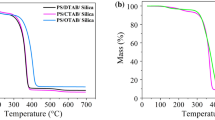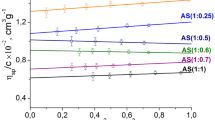Abstract
In this work, the evaluation of a newly developed anionic polymerizable surfactant (surfmer), viz., sulfonated 3-pentadecyl phenyl acrylate, in the emulsion polymerization of styrene and its effect on the polymer properties is reported. The results were compared with the commercially available non-reactive anionic surfactant sodium lauryl sulfate. The surfmer has a low critical micellar concentration value of 40.11 mg/L (8.7 × 10−5 mol/L) in comparison to 2,400 mg/L (8.28 × 10−3 mol/L) for sodium dodecyl sulfate. Nanosized polystyrene dispersions with varying concentration of this surfmer were prepared and characterized for conversion, particle size, and size distribution at a fixed monomer/water ratio of 0.1. The particle radii decreased from 560 nm for the surfactant-free dispersions to 45 nm for the dispersion with 2.3 mol% surfmer. Increasing surfmer content above this concentration did not further affect the particle size but increased the width of the particle size distribution. Transmission electron microscopy results along with particle size data show that with increasing surfmer content the particle size distribution broadens, and film formation is facilitated. The microstructure analysis of the copolymers using infrared and 1H-NMR spectroscopy confirms that the surfmer is chemically attached to the polymer chains. The effect of the ionic sulfonate groups and the alkyl chains of the surfmer moieties on the polymer properties have been studied through measurement of dilute solution viscosity and thermal and viscoelastic properties. These results indicate that the behavior of surfmer-containing polymers resembles that of plasticized ionomers.











Similar content being viewed by others
References
Gilbert RG (1995) Emulsion polymerization: a mechanistic approach. Academic Press, London
El-Aasser MS, Sudol ED (1997) In: Lovell PA, El-Aasser MS (eds) Emulsion polymerization and emulsion polymers. John Wiley and Sons, London, p 37
Asua JM (2004) Emulsion polymerization: from fundamental mechanisms to process developments. J Polym Sci Part A Polym Chem 42:1025–1041
Freedman HH, Mason JP, Medalia AI (1958) Polysoaps II. The preparation of vinyl soaps. J Org Chem 23:76–82
Guyot A, Tauer K, Asua JM, EsS V, Gambier C, Hellgren AC et al (1999) Reactive surfactants in heterophase polymerization. Acta Polym 50:57–66
Cannon LA, Pethrick RA (2002) Comparison of the effect of reactive and non-reactive steric stabilizers on the mechanism of film formation in methyl methacrylate/butyl acrylate copolymers latexes. Part 1. Differential scanning calorimetry, dynamic mechanical analysis and atomic force microscopy. Polymer 43:6421–6428
Matahwa H, Mcleary JB, Sanderson RD (2006) Comparative study of classical surfactants and polymerizable surfactants (surfmers) in the reversible addition-fragmentation chain transfer mediated miniemulsion polymerization of styrene and methyl methacrylate. J Polym Sci Part A Polym Chem 44:427–442
Holmberg K (1992) Polymerizable surfactants. Prog Org Coat 20:325–337
Lai Z, Sudol ED, Dimonie VL, El-Aasser MS (2005) Determination of the extent of incorporation of a reactive surfactant in polystyrene latex particles via GPC. J Polym Sci Part A Polym Chem 43:2675–2678
Unzué MJ, Schoonbrood HAS, Asua JM, Goni AM, Sherrington DC, Stähler K, Goebel KH, Tauer K, Sjoberg M, Holmberg K (1997) Reactive surfactants in heterophase polymerization. VI. Synthesis and screening of polymerizable surfactants (surfmers) with varying reactivity in high solids styrene–butyl acrylate–acrylic acid emulsion polymerization. J Appl Polym Sci 66:1803–1820
Schoonbrood HAS, Unzué MJ, Beck O, Asua JM, Goñi AM, Sherrington DC (1997) Reactive surfactants in heterophase polymerization. 7. Emulsion copolymerization mechanism involving three anionic polymerizable surfactants (surfmers) with styrene-butyl acrylate-acrylic acid. Macromolecules 30:6024–6033
Tauer K, Zimmermann A, Schlaad H (2002) New reactive block copolymers as stabilizers in emulsion polymerization. Macromol Chem Phys 203:319–327
Guyot A (2002) Recent progress in reactive surfactants in emulsion polymerization. Macromol Symp 179:105–132
Sindt O, Gauthier C, Hamaide T, Guyot A (2000) Reactive surfactants in heterophase polymerization. XVI. Emulsion copolymerization of styrene-butyl acrylate-acrylic acid in the presence of simple maleate reactive surfactants. J Appl Polym Sci 77:2768–2776
Tichagwa L, Götz C, Tonge M, Sanderson R, Pasch H (2003) The use of selected acrylate and acrylamide-based surfmers and polysoaps in the emulsion polymerization of styrene. Macromol Symp 193:251–260
Klimenkovs I, Zhukovska I, Uzulina I, Zicmanis A, Guyot A (2003) Maleic diamide polymerizable surfactants. Applications in emulsion polymerization. Compt Rendus Chim 6:1295–1304
Asua JM, Schoonbrood HAS (1998) Reactive surfactants in heterophase polymerization. Acta Polym 49:671–686
Prasath RA, Ramakrishnan S (2005) Synthesis, characterization, and utilization of itaconate-based polymerizable surfactants for the preparation of surface-carboxylated polystyrene latexes. J Polym Sci Part A Polym Chem 43:3257–3267
Herold M, Hãkanson M, Brunner H, Tovar GEM (2006) Modular surfmers with activated ester function—a colloidal tool for the preparation of bioconjugative nanoparticles. Prog Colloid Polym Sci 133:30–34
Mestach D (2004) Reactive surfactants for commercial polymer dispersions. Prog Colloid Polym Sci 124:37–41
Peungjitton P, Sangvanich P, Pornpakakul S, Petsom A, Reongsumran S (2009) Sodium cardanol sulfonate surfactant from cashew nut shell liquid. J Surf Deterg 12:85–89
Tyman JHP, Bruce IE (2003) Synthesis and characterization of polyethoxylate surfactants derived from phenolic lipids. J Surfact Deterg 6:291–297
Suresh KI, Gesche F, Schubert R, Bartsch E (2012) Synthesis and micellization properties of new anionic reactive surfactants based on hydrogenated cardanol. J Surfact Deterg 15:207–215
Young LJ (1969) In: Brandrup J, Immergut EH (eds) Polymer handbook, 2nd edn. John Wiley & Sons, New York
Rodriguez MP, Preito G, Rega C, Vrela ML, Sarmiento F, Mosquera V (1998) A comparative study of the determination of the critical micelle concentration by conductivity and dielectric constant measurements. Langmuir 14:4422–4426
Suresh KI, Othegraven J, Raju KVSN, Bartsch E (2004) Mechanistic studies on particle nucleation in the batch emulsion polymerisation of n-butyl acrylate containing multifunctional monomers. Coll Polym Sci 283:49–57
Xu XJ, Siow KS, Wong MK, Gan LM (2001) Polymerization of styrene with ionic co-monomer, nonionic co-monomer or both. J Polym Sci Part A Polym Chem 39:1634–1645
Sanderson RD, Meincken M (2002) Determination of the influence of the polymer structure and particle size on the film formation process of polymers by atomic force microscopy. Polymer 43:4947
Xu XJ, Chen F (2004) Semi-continuous emulsion copolymerization of butyl methacrylate with polymerizable anionic surfactants. Polymer 45:4801–4810
Yang JC, Jablonsky MJ, Mays JW (2002) NMR and FT-IR studies of sulfonated styrene-based homopolymers and copolymers. Polymer 43:5125–5132
Suresh KI, Jaikrishna M (2005) Synthesis of novel crosslinkable polymers through ATRP of cardanyl acrylate. J Polym Sci Part A Polym Chem 31:1069–1073
Lundberg RD (1987) In: Bikales NM, Overberger CG, Menges G (eds) Encyclopedia of polymer science & engineering, vol 8. John Wiley & Sons, New York, pp 393–423
Eisenberg A (1970) Clustering of ions in organic polymers. A theoretical approach. Macromolecules 3:147–154
Misra N, Banthia AK, Mandal BM (1979) Intermolecular association of polymers through functional end-groups: sulphate and sulphonate end-groups. Eur Polym J 15:943–947
Xu L, Li X, Zhai M, Huang L, Peng J, Li J, Wei G (2007) Ion-specific swelling of poly(styrene sulfonic acid) hydrogel. J Phys Chem B111:3391–3397
Lucaa ED, Waigh TA, Kim JS, Jeon HS, Hintzen WP (2005) Phase separation in randomly charged polystyrene sulfonate ionomer solutions. Polymer 46:7109–7119
Huggins ML (1942) The viscosity of dilute solutions of long chain molecules. IV. Dependence on concentration. J Am Chem Soc 64:2716–2718
Zhang S, Dou S, Colby RH, Runt J (2005) Glass transition and ionic conduction in plasticized and doped ionomers. J Non-Cryst Solids 351:2825–2830
Eisenberg A (1971) Glass transition in ionic polymers. Macromolecules 4:125–128
Mokrini A, Rio CD, Acosta JL (2004) Synthesis and characterization of new ion conductors based on butadiene styrene copolymers. Solid State Ionics 166:375–381
Neuse EW, Van Schalkwyk JD (1977) Cardanol derivatives as PVC plasticizers. II. Plasticizer evaluation. J Appl Polym Sci 21:3023–3033
Souza FG Jr, Soares BG, Siddaramaiah Barra GMO, Herbst MH (2006) Influence of plasticizers (DOP and CNSL) on mechanical and electrical properties of SBS/polyaniline blends. Polymer 47:7548–7553
Schantz S, Carlsson HT, Andersson T, Erkselius S, Larsson A, Karlsson OJ (2007) Poly(methyl methacrylate-co-ethyl acrylate) latex particles with poly(ethylene glycol) grafts: structure and film formation. Langmuir 23:3590–3602
Acknowledgments
This research was supported by a Marie Curie International Incoming Fellowship to Dr. K.I. Suresh within the 7th European Community Framework Program (FP7) under contract No. PIIF-GA-2008-220349.
Author information
Authors and Affiliations
Corresponding author
Rights and permissions
About this article
Cite this article
Suresh, K.I., Bartsch, E. Effect of sulfonated 3-pentadecyl phenyl acrylate as surfmer in the emulsion polymerization of styrene: synthesis and polymer properties. Colloid Polym Sci 291, 1843–1853 (2013). https://doi.org/10.1007/s00396-013-2919-8
Received:
Revised:
Accepted:
Published:
Issue Date:
DOI: https://doi.org/10.1007/s00396-013-2919-8




